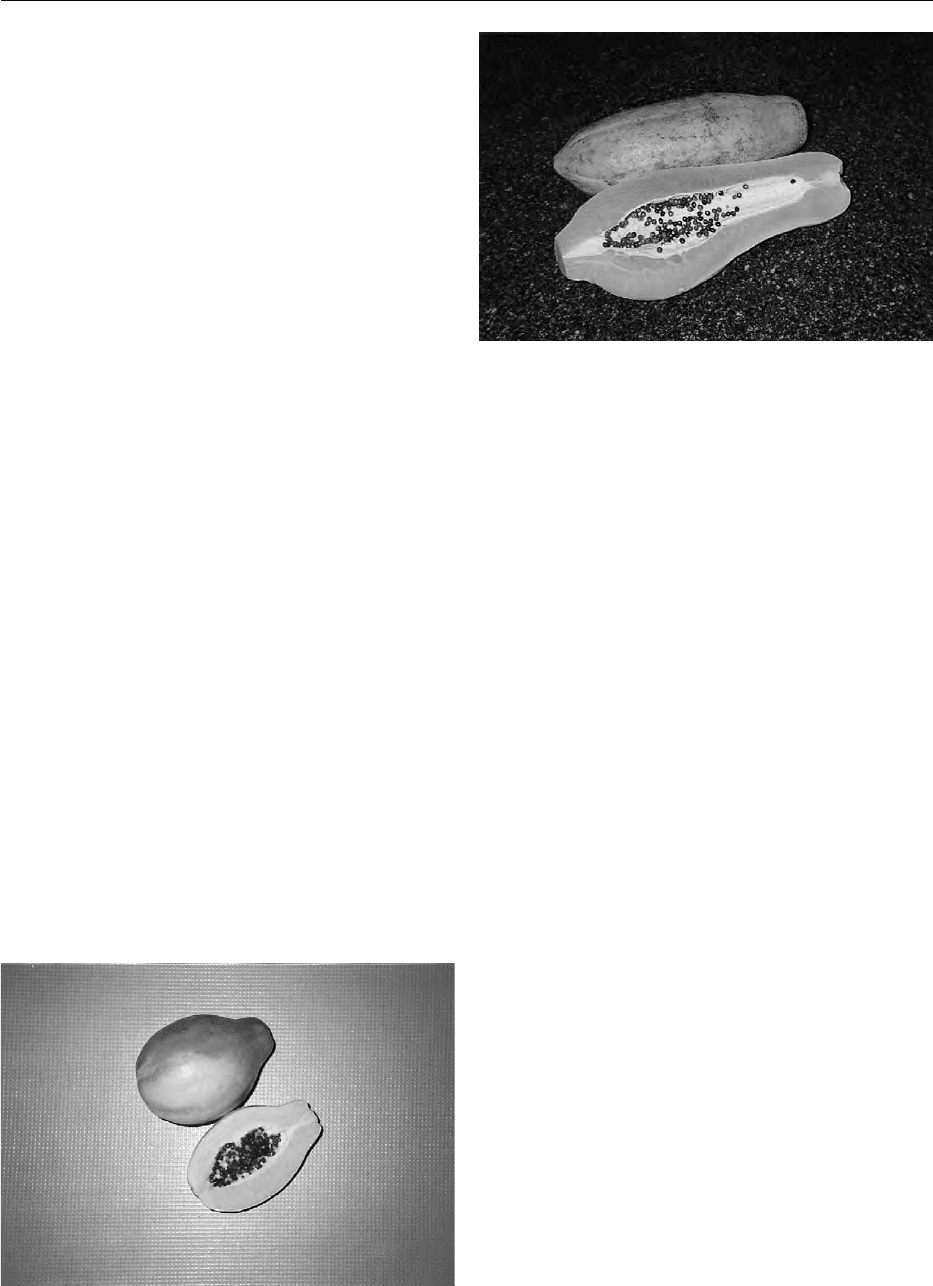Caballero B. (ed.) Encyclopaedia of Food Science, Food Technology and Nutrition. Ten-Volume Set
Подождите немного. Документ загружается.


Tahiliani AG and Beinlich CJ (1991) Pantothenic acid in
health and disease. Vitamins and Hormones 46:
165–228.
Wedegaertner PB and Bourne HR (1994) Activation and
depalmitoylation of G
sa
. Cell 77: 1063–1070.
PAPAYAS
J H Moy, University of Hawaii at Manoa, Honolulu,
USA
Copyright 2003, Elsevier Science Ltd. All Rights Reserved.
Introduction
0001 Papaya, a mildly sweet, melon-like tropical fruit
belonging to the family Caricacae, is a native of
tropical America (Central America and the Carib-
bean, including Mexico, Costa Rica, and the Baha-
mas). After the Spaniards took the fruit to Luzon
Island in the Philippines in the mid sixteenth century,
it reached Malacca shortly afterward, and then India.
It has been widely grown throughout tropical and
subtropical regions such as Australia; Hawaii, Flor-
ida, Texas, California, and Puerto Rico in the USA;
Peru; Venezuela; various parts of Central and South
Africa; and Bangladesh, Pakistan, and India. The
Australians call it ‘pawpaw’ while the Venezuelans
call it ‘lechosa.’
0002 Fruit size may vary from less than 0.5 kg to 3 kg. A
climacteric fruit, it is mainly consumed fresh when
ripened after harvest. Ripening is judged by the ap-
proximate percentage of yellowness on its skin, and
more accurately by measuring its total soluble solids
(TSS) contents with a refractometer. Export-grade
papayas grown in Hawaii should have a minimum
of 11.5% TSS. Firmness, as gaged by touch or by a
texture-measuring device, is another way of judging
ripening. The firmness is related to the biochemical
changes in three fractions of pectins in papayas, and is
not a very accurate index of ripeness. Green papayas
can also be consumed as a salad or in soups, both of
which are quite popular in South-east Asia.
0003 Hawaii, part of the USA, is the world’s largest
exporter of papayas, with about 16 000 t in 1999,
valued at US$14.15 million. Most of the outship-
ments are to the US mainland, with about 25%
going to Japan. Brazil is the second largest exporter,
with most papayas going to European countries such
as Germany, France, and the UK. Kenya, the Ivory
Coast, and Malaysia also ship papayas to European
markets. For recent shipment statistics, (See Fruits
of Tropical Climates: Commercial and Dietary Im-
portance.)
Species and Cultivars
0004Papaya belongs to the family Caricaceae – a small,
somewhat anomalous family with four genera and 31
species, of which three are in tropical and subtropical
America and one in Africa. The genera and the
number of included species are: Carica, 22; Facaratia,
6; Farilla,1;andCylicomorpha, 2. The edible fruits
are found only in Carica, of which C. papaya, the
common papaya, is extensively grown. Other species
include: C. chilensis, C. goudotiana, C. monoica, and
C. pubesceus. C. candamarcensis, known as moun-
tain papaya, grows to a height of about 2.5 m, toler-
ates low temperature, and thrives well at an elevation
between 1500 and 2000 m. C. monoica grows in the
Amazon basin.
0005A large number of papaya cultivars are grown in
different parts of the tropical and subtropical regions.
However, none are true cultivars because they do not
reliably transmit the parental characters to all their
progeny. Some of the better known cultivars are listed
below, with their average weight in kg in parentheses:
1.
0006Washington (0.9–1.0)
2.
0007Honey dew (1.1–1.5)
3.
0008Coimbatore 1 (1.2–1.5) – a selection from the
progenies of cv. Ranchi
4.
0009Coimbatore 2 (1.0–1.5) – a high papain-yielding
cultivar
5.
0010Coimbatore 3 (0.9–1.0) – a hybrid between Co. 2
and Sunrise Solo
6.
0011Coimbatore 4 (1.3–1.5) – a cross between Co.
1 and Washington (The coimbatore cultivars
were released from the Tamil Nadu Agricultural
University, Coimbatore.)
7.
0012Pusa Delicious (1.0)
8.
0013Pusa Majesty (0.95)
9.
0014Pusa Giant (1.9)
10.
0015Pusa Dwarf (1.0) (The pusa cultivars were bred
at the India Agricultural Research Institute
Regional Station, Pusa, Bihar.)
11.
0016Sunrise Solo (0.4–1.0) – red-fleshed
12.
0017Sunset Solo (0.4–1.0) – red-fleshed
13.
0018SunUp (0.4–1.0) – a genetically transformed
sunset, red-fleshed
14.
0019Kapoho Solo (0.5–1.4) – yellow-fleshed
PAPAYAS 4345

15.0020 Waimanalo Solo (0.5–1.4) – yellow-fleshed
16.
0021 Rainbow (0.5–1.4) – a transgenic cross between
Kapoho and SunUp, yellow-fleshed (The two
transgenic cultivars have been grown on the
island of Hawaii since 1998)
17.
0022 Pink-Fleshed Sweet (0.85)
18.
0023 Thailand (1.9–2.2)
0024 Other important cultivars are: Guinea Gold, Sun-
nybank, and Hybrid 5 (Australia); Hortus Gold and
Honey Gold (South Africa); Tai Ning No. 2, Panama
red and Solo No. 1 (Taiwan); Red Rock and Cariflora
(Florida, USA); Red Fleshed, (Philippines); Madhu-
bindu, Barwani, Ranchi, and Peradeniya (India).
Botany and Horticulture
0025 Papaya is a herbaceous, unbranched plant. Its stem is
supported by phloem fibers encircling a hollow stem,
which can grow up to 8–10 m high. Its leaves are
large, deeply lobe-shaped with long hollow petioles,
and spirally crown the stem. Flowers, male and
female, can be on the same plant (monoecious) or
on separate plants (dioecious), or as male and female
parts on the same flower (hermaphrodite).
0026 Papaya fruits are mostly round in the female tree
and cylindrical and pear-shaped in the hermaphrodite
tree. Underneath the smooth, thin skin (green when
immature, orange-yellow when ripe) is a thick layer
of deep yellow to orange-red pericarp with an ellip-
tical, central cavity containing many small, round
black seeds coated with jelly-like tissues (Figures
1 and 2).
Planting
0027 The three major environmental factors to consider in
selecting a site to grow papayas are temperature,
moisture (rainfall and soil drainage), and wind. The
hermaphrodite papaya plant preferred for commer-
cial orchards is more sensitive to its growing environ-
ment than the female papaya plant. Selection of a
suitable site is therefore critical. Another condition
to consider is the amount of sunlight the site receives
to support plant growth and fruit production. Insuffi-
cient sunlight results in fruits with inadequate sugar
and low yields, and encourages plant diseases that
affect papaya production.
0028The temperature of the site is the most important
factor. Optimal production is generally limited to
elevation under 160 m within a temperature range of
16–31
C. Temperature below 16
C could cause car-
peloidy, resulting in ‘cat-face’ deformity when floral
stamens develop abnormally into fleshy, carpel-like
structures. High temperature (32–35
C) may induce
female sterility, in which normally hermaphroditic
papaya plants produce male flowers, resulting in
poor fruit set and production.
0029A minimum monthly rainfall of 10 cm and an aver-
age relative humidity of 66% are considered ideal for
papaya growth and production. Drip irrigation can
supplement low rainfall. Good soil drainage is also
essential. When soil drainage is restricted, papaya is
susceptible to fungal root diseases. The plants are
severely affected by waterlogging and can be killed
when subjected to puddled conditions for even a few
hours. The Puna area on the island of Hawaii is well-
suited to commercial papaya production because of
the very porous lava soils.
0030Papaya plants must be protected from wind. Plants
exposed to constant wind develop deformed, crinkled
leaves. When wind stress damage is excessive, the
plant growth, fruit set, fruit quality, and productivity
will be reduced. Wind-blown dust can cause sap
bleeding that harms fruit appearance. In coastal
fig0001 Figure 1 (see color plate 119) Rainbow cultivar growing in
Hawaii, weighing 0.66 kg.
fig0002Figure 2 (see color plate 120) Thailand cultivar growing in
Thailand, weighing 2.50 kg.
4346 PAPAYAS

areas, salt spray carried by wind can desiccate leaves
and kill papaya plants. Winds of 64 km h
1
can
uproot papaya trees growing in mineral soils, espe-
cially when accompanied by heavy rain. Windbreaks
should be established well in advance of planting a
papaya crop. On the other hand, adequate air move-
ment is important in reducing incidence of fungal
diseases such as phytophthora and anthracnose.
These diseases can become severe when there is
excessive free moisture and high humidity around
the plant.
0031 Papaya can either be seeded directly or trans-
planted into a new field. Direct seeding can be prac-
ticed in porous soil. Six-week-old seedlings can be
transplanted into less porous fields. Planting in
‘virgin’ lands or fields in which papaya has not been
grown before is preferred because of low disease and
insect pressure. However, it is becoming increasingly
difficult to find such fields. Other important horticul-
tural aspects of planting papaya are plant sex selec-
tion, thinning, fertilizer applications, leaf trimming,
weed control, pest management, and disease control.
Transgenic Cultivars
0032 For more than four decades, papaya production in the
Hawaiian island chain was severely affected by the
papaya ringspot virus (PRV). In the 1960s, papaya
planting was forced to move from the island of Oahu
to the Puna area of the island of Hawaii. Since 1992,
the introduction and subsequent spread of PRV in
commercial orchards in Puna has resulted in a signifi-
cant decrease in papaya production in the state of
Hawaii.
0033 The only solution seemed to be to produce a trans-
genic cultivar that would be resistant to the virus.
Faced with this extremely challenging task, molecular
biologists from Cornell University, the University of
Hawaii, and the Upjoin Company collaborated from
1987 to 1991 to obtain the first transformed plant
that appeared to have PRV resistance. It took several
more years for plant breeders at the University of
Hawaii to inbreed the resistant plant to produce a
tree-breeding, redfleshed cultivar that was named
UH sunup (also referred to as SunUp). Because the
papaya industry wanted a yellow-fleshed fruit, plant
breeder Richard Manshardt crossed SunUp with
Kapoho to produce a yellow-fleshed F
1
hybrid that
was named UH Rainbow (also called Rainbow).
0034 SunUp is totally resistant to the virus, but Rain-
bow, in greenhouse studies, has shown susceptibility
to PRV until about 7 weeks of age. This is referred to
as young plant susceptibility. The plants become fully
resistant to PRV after 3 months of age. The hybrid
Rainbow has some differences from the Kapoho: (1) a
lower sex-segregation ratio; (2) plants grown from
seeds of F
1
hybrids do not breed true; (3) a higher
sensitivity to calcium deficiency; (4) more sensitive to
phythophthora and will require timely application of
fungicides; and (5) ripens faster than Kapoho but
slower than Sunrise fruits.
0035These two lines of transgenic cultivars have been
rigorously reviewed and approved by three US agen-
cies: the US Department of Agriculture (USDA), the
Environmental Protection Agency (EPA), and the
Food and Drug Administration (FDA). The USDA
determined that these new plants would not contam-
inate other existing germ plasma, and they would not
foster a new strain of virus. The USDA concluded,
therefore, that they posed no hazards to agriculture in
the USA. The EPA sets tolerance limits for regulated
chemicals. The coat protein used in the genetic engin-
eering process was considered a pesticide, to be regu-
lated because its function is to eliminate diseases. The
EPA subsequently agreed with University of Hawaii
scientists that there was no tolerance required for coat
protein. The FDA’s job is to protect the public from
unsafe products. The FDA was satisfied that the nu-
trients of the original material (fruit) were retained,
and therefore did not require a toxicity test. All three
agencies declared the two transgenic cultivars safe for
human consumption.
0036Those wishing to purchase seeds of transgenic
papaya cultivars must adhere to a licensing process
as well as sign a sublicense agreement with the Papaya
Administrative Committee in the state of Hawaii.
Nutrient Composition and Fruit Chemistry
Nutrient Composition
0037The papaya fruit is a good source of ascorbic acid
(vitamin C) and carotenoids (provitamin A), two
important nutrients for people in the subtropical
and tropical regions. Table 1 shows the nutrient com-
position of papaya from data published in 1965,
1990, and 1999.
Chemistry and Biochemistry
0038Sugars are the principal carbohydrates in papayas,
with very little starch. Refractometric measurements
of total soluble solids (%TSS) show some differences
in various cultivars. Those grown in Florida have
been reported to range from 5.6 to 7.2%; those in
India vary from 6.5 to 13%, while the Hawaiian
cultivars measure 11.5–13.5%. The sugars in ripe
papayas in which the invertase has been inactivated
were reported to be 48% sucrose, 30% glucose, and
22% fructose.
0039Papaya is a low-acid fruit, with the total titratable
acidity of about 0.1% calculated as citric acid. The
PAPAYAS 4347

pH of the pulp ranges from 5.5 to 5.9, far higher than
the pHs of other tropical fruits at 3.2–4.5, which
explains the low tartness of the papaya fruit. The
organic acids in papayas are mainly equal amounts
of malic and citric acid, with smaller amounts of
ascorbic and a-ketoglutaric acid.
0040 The volatile flavors of papayas were reported to
consist of 124 compounds. Linalool is the major
component with characteristic fresh papaya aroma
and flavor. Benzyl isothiocyanate, another major
component, has a pungent off-aroma. Other off-
aroma, off-flavor compounds in papaya pulp have
been identified as butyric, hexanoic, and octanoic
acids and their corresponding methyl esters. These
components were analyzed with gas chromatography
and mass spectrometry. (See Chromatography: Gas
Chromatography; Flavor (Flavour) Compounds:
Structures and Characteristics; Mass Spectrometry:
Principles and Instrumentation.)
0041 Carotenoids are the pigments of the ripe papaya
flesh, which is deep yellow. Red-fleshed papaya culti-
vars additionally contain lycopene, which gives the
pulp an orange-red color. (See Colorants (Colourants):
Properties and Determination of Natural Pigments.)
0042 In addition to papain being an economically
important enzyme in green papaya, several other
enzymes play a role in the stability and quality of
processed papaya products. Pectinesterase (3.1.1.11),
the enzyme responsible for gel formation in unheated
papaya pure
´
e, contributes to some increase in acidity
in pure
´
e as a result of demethoxylation of the carb-
oxyl groups in the pectins. Thioglucosidase (myrosi-
nase) (3.2.3.1) is responsible for generating benzyl
isothiocyanate, a sulfurous, pungent, odiferous com-
pound which contributes to the off-aroma of papaya
products. When fruit tissues are macerated, acid
phosphatase (3.1.3.2) catalyzes the hydrolysis of the
P–O bond of orthophosphoric monoesters, producing
ROH and phosphoric acid, which increases the acid-
ity of the pure
´
e. Another enzyme, b-fructofuranosi-
dase (invertase) (3.2.1.26), is responsible for the
hydrolysis of sucrose to fructose and glucose.
Harvesting, Handling, and Storage
0043Summer fruits become mature in 22 weeks, while 26
weeks are needed during the winter. Fruits are typic-
ally harvested weekly or twice weekly at color-break
(a tinge of yellowness on a green fruit) by hand, or
with the aid of a cut-off ‘plumber’s helper’ (a rubber
suction cup) attached to a pole for hard-to-reach
fruits. Fruits can also be harvested with a ladder, or
from a large fruit bin mounted on a tractor high-lift.
Careful handling with minimal bruising and abrasion
helps with postharvest sorting, packing, shipping,
and marketing.
0044To control fungal decay of postharvested fruit, a
dip in hot water at 49
C for 20 min was found to be
very effective. Hot-water spray with fungicide or a
wax dip containing fungicide is also effective.
0045Storing papayas at temperatures below 7
C after
harvest can result in chill injury. The recommended
storage temperature is 10
C.
Quarantine Treatment
0046Fruit flies and other insect pests are prevalent in the
tropics and the subtropics. Most soft tropical fruits
are prone to infestation by fruit flies. A quarantine
treatment approved by the plant quarantine authority
of each country must be applied to fruits before they
can be exported to noninfested areas. Up until 1984,
chemical fumigants such as ethylene dibromide (EDB)
were widely used, until tests showed them to be car-
cinogenic to laboratory animals. Since then, quaran-
tine treatment options are thermal or cold treatment,
or irradiation.
0047Papayas grown in Hawaii are infested with four
species of fruit flies: the Oriental fruit fly (Dacus
dorsalis), the Mediterranean fruit fly (Ceratitis capi-
tata), the melon fly (Dacus cucurbitae), and the Ma-
laysian fruit fly (Bactrocera latifrons). After EDB was
banned, a double-dip hot-water treatment (42
C for
tbl0001 Table 1 Nutrient composition of papaya per 100 g of edible pulp
Moisture (%) 86–89
Carbohydrate (g) 9.5–12.2
Protein (N 6.25: g) 0.36–0.5
Fat (g) 0.06–0.1
Fiber (g) 0.5–0.6
Ash (g) 0.5–0.6
Ascorbic acid (mg) 40–84
Vitamin A (mg) 11–32
a
Thiamin (mg) 0.027–0.04
Riboflavin (mg) 0.043–0.25
Niacin (mg) 0.20–0.33
Calcium (mg) 10–30
Phosphorus (mg) 10–12
Iron (mg) 0.2–4.0
Energy (cal) 40–48
a
Vitamin A data assuming 12 mgofall-trans b-carotone ¼ 1 mg all-trans
retinol.
Sources of data: Wenkam NS and Miller: CD (1965) Composition of Hawaii
Fruits. Bulletin 135. Honolulus, Hawaii: Hawaii Agricultural Experiment
Station, University of Hawaii at Manoa; Muthukrishnan CR and Irulappan I
(1990) In: Bose TK and Mitra SK (eds) Fruits: Tropical and Subtropical, pp.
303–335. Calcutta: Naya Prokash. Moy JH, Paull RE, Bian X, Chung R and
Wong L (1999) Quality of tropical fruits irradiated as a quarantine
treatment. In: Moy JH and Wong L (eds). Proceedings of the workshop on the
use of Irradiation as a Quarantine Treatment of Food and Agricultural
Commodities pp. 45–53. Honolulu, Hawaii: College of Tropical Agriculture
and Human Resources, University of Hawaii and Dept of Hawaii, State of
Hawaii.
4348 PAPAYAS

30 min, 49
C for 20 min) was used but was aban-
doned after 3 years because a high percentage of
treated fruits became injured by the heat. Subse-
quently, two other thermal treatments were used.
One is a modified vapor heat treatment, and the
other is called a high-temperature forced-air (HTFA)
procedure. Both are very similar. The difference is the
relative humidity of the heated air admitted to the
treatment chambers. The air in the vapor heat treat-
ment has moisture added to the air throughout, with
the relative humidity kept at 90% or above. In the
HTFA method, ambient air is heated and admitted
into the chamber, and only in the last hour of a 4-h
treatment is the relative humidity required to be kept
at 90–100%. Both methods require about 4 h to reach
the endpoint, which is when the center of the fruit
reaches 47.2
C. Fruits are then cooled with a water
spray for about 30 min. Several fruit packers in
Hawaii are using these methods, which work quite
well. However, both are time-consuming and com-
modity-specific. Total uniformity in heating is also
difficult to achieve because of variation in fruit size,
fruit ripeness (affecting thermal conductivity and heat
transfer rates), and physical locations within a cham-
ber. After heat treatment, it is common to find lumpy
texture and lack of flavor in a few percent of the heat-
treated fruits in each batch, caused by enzymes
responsible for ripening being inactivated by heat.
0048 Cold treatment requires that fruits be kept at 1 or
2
C for 12–14 days to immobilize and inactivate fruit
fly eggs and larvae before the fruits can be taken to
the supermarkets. Not many tropical fruits can toler-
ate this time–temperature regime, papaya being one
of them.
0049 Though somewhat controversial, several decades
of research in Hawaii and in other parts of the
world have proven that irradiation is the most effica-
cious quarantine treatment procedure. The treatment
is efficient (15–20 min in a commercial irradiator)
and effective (all fruits are thoroughly irradiated to
cause the fruit fly eggs and larvae to be sexually
sterilized, regardless of fruit size and ripeness). Irradi-
ated papayas ripen normally or slightly delayed,
and their chemical, physical, nutrient, and sensory
qualities are well retained. Radiation sources can be
gamma-rays (from cobalt-60), an electron beam (with
limited penetration), or X-rays (converted from
e-beam). Fruits irradiated will not become radioactive
because there is a limit on the energy level used. In
April 1995, Hawaii became the first place in the world
to use irradiation as a quarantine treatment of its
papayas and other tropical fruits. The generic quar-
antine dose approved by the USDA is 0.25 kGy.
Starting in 2001, more countries will be using this
technology to treat their fruits for export markets.
Processed Products
Chunks (Refrigerated or Frozen)
0050After being washed, deseeded, and peeled, papayas
can be cut into chunks, then refrigerated or frozen as
a convenient food. It is available in some super-
markets in the salad section. Another niche market
for this type of product is the airlines. A number of
airlines prefer the convenience of serving these pre-
pared fruits to their passengers. The frozen chunks
are more suitable for serving with ice cream or for
further manufacturing into dessert products.
Canned (Mixed with Other Fruits)
0051Papaya can be made into a canned product, or as a
cocktail of several fruits. Chunks or dices of papayas
or mixed fruits can be filled into a can and covered
with hot (75
C), acidified syrup (c.40
Brix with pH
adjusted to 3.6–3.8 with citric acid: 40
Brix ¼40 g of
sugar mixed with 60 g of water at 20
C). After the air
in the head space in the cans (c. 6.3–8.0 mm) has been
exhausted by steam, the cans are sealed and pasteur-
ized with steam, or in a boiling-water bath. (See
Canning: Principles.)
Pure
´
e
0052Papaya pure
´
e is prepared in the form of a free-flowing
paste, without seeds, skin, or unwanted fiber. The
pure
´
e can be an intermediate product used for manu-
facturing several end products such as juices, nectars,
jams, jellies, syrups, and dried fruit rolls or leathers.
Papaya pure
´
e and other fruit pure
´
es in the USA can be
manufactured with a high degree of mechanization.
Several aspects of pure
´
e manufacturing are important
to produce a quality product.
1.
0053Ripe papaya fruits should be steamed for 2 min to
coagulate the latex in the peel, preventing the latex
from entering into the pure
´
e. Also, steaming
increases pure
´
e yield by softening the outer layers
of the fruit, and inactivates enzymes in the peel.
The fruits are spray-cooled to remove the re-
sidual heat.
2.
0054Fruits are sliced, crushed, and dropped into a
centrifugal separator. All the skin and most of
the seeds are separated. The remaining seeds
are separated in a paddle pulper fitted with
rubber paddles and a small screen (c. 0.80–
0.85 mm).
3.
0055The pure
´
e is acidified with citric acid (a 50%
solution) to a pH of about 3.4–3.6 to inhibit
gelatin of the pure
´
e. Acidification also helps con-
trol microbial activity and enhances the effect of
subsequent heat pasteurization.
PAPAYAS 4349

4.0056 A smooth pure
´
e can be obtained by passing the
liquid through a paddle finisher with a 0.50 mm
screen to remove seed specks and undesirable
fiber.
5.
0057 The pure
´
e is pasteurized in a heat exchanger at
94
C for 2 min, then cooled to a few degrees
above ambient temperature.
6.
0058 The pure
´
e can be aseptically packed in suitable
flexible containers, or frozen in bulk at 20
C
or below.
Beverages
0059 Juice, drinks, nectars, and cordials can be prepared
from papaya pure
´
e through formulation by adding
appropriate amounts of water, sweeteners, and
acidulants to the pure
´
e. Commonly used acidulants
include citric acid, malic acid, lemon and lime juice.
These beverages can be pasteurized in bottles or cans
after being acidified to a pH below 4.4.
Dried Products
0060 Several forms of dried products can be prepared from
papaya slices. Since papaya is a soft fruit when fully
ripe, three-quarter ripe fruits are more suitable for
preparing dried slices. Drying can be carried out in
a hot-air drier, a vacuum drier or a freeze drier, with
increasing product quality but correspondingly
higher cost. Solar drying of papaya slices is also a
very practical means of preserving papaya with
good quality. The final moisture content of dried
papaya should be around 5–8% (wet weight basis).
Good packaging is important to retain quality and to
prevent insects from entering the package. University
of Hawaii researchers have designed and built a con-
tinuous solar drier on the island of Kauai in Hawaii,
capable of drying 450 kg of papaya slices within a
24-h period. This drier uses only renewable energy –
solar and biogas.
0061 University of Hawaii researchers have also de-
veloped a vacuum-puff freeze drying process to
make high-quality juice powder, including papaya.
The process involves mixing a papaya pure
´
e with a
small amount of sucrose, freezing the mixture, and
then placing it into a freeze drier. Initially, the pure
´
e–
sucrose or juice–sucrose mixture puffs into a foam
when raised to its freezing point. It then refreezes
under a good vacuum. The endpoint is reached
when 1% of moisture is left. The freeze-dried product
is a crystalline powder, and can be rehydrated into
a nectar, similar to freeze-dried coffee. Freeze-dried
powders also retain the color and flavor of the
original pure
´
e or juice with the right degree of
sweetness.
Papain
Source
0062A milky latex in immature papaya fruit contains an
enzyme called papain. Papain from the dried latex
is in great demand on the international markets,
especially in the UK and the USA.
Properties
0063Papain is a proteolytic enzyme, capable of hydrolyz-
ing or breaking down protein materials.
Applications
0064In the food, pharmaceutical, textile, and tanning
industries, papain is used as a meat tenderizer; for
clearing beer; in the manufacture of cosmetics such
as face creams and dental creams; in degumming
silk and rayon; in the preshrinking of wool; and in
tanning leather.
0065In the medical field, papain can be used to treat
necrotic tissues, dyspepsia and other digestive ail-
ments, ringworm and roundworm infections, skin
lesions and ulcers, eczema, and other skin diseases
and kidney disorders. Papain is used in detecting
stomach and intestinal cancers and also in correcting
diphtheria.
Production
0066The latex of a green papaya drips into a container
after the skin is slit. Papain is the dried latex in
powder form. The collection of latex is very labor-
intensive. Papain production is influenced by several
factors:
1.
0067Fruit size and shape: oblong fruits 36 cm in length
and 28 cm in diameter were found to give the
highest papain yield. In general, papain yield
increases with increasing fruit size.
2.
0068Fruit maturity: unripe but fully grown fruits yield
maximum papain, especially when fruits have
been grown to 75–90 days after fruit set.
3.
0069Season: the flow of latex is low if the temperature
is below 10
C.
4.
0070Cultivars: in India and Sri Lanka, cultivars found
to have high papain yield were Washington,
Philippine, Botanist’s Selection, Peradeniya and
Coimbatore 1.
Yield
0071Papain yield varies from 1.23 to 7.45 g per fruit
among nine cultivars, with the cultivar Washington
recording the highest mean yield of 7.45 g per fruit. In
a papaya tree, the total papain yield can vary from
150 g to 227 g.
4350 PAPAYAS

Role of Papaya in Human Health
0072 The flesh of papaya contains high levels of three car-
otenoids: b-cryptoxanthin, b-carotene, and lycopene.
Different papaya cultivars vary in concentrations and
ratios of these carotenoids. It has been reported that
many individual carotenoids, including b-carotene
and lycopene, have the ability to prevent transform-
ation of cells to cancer phenotypes in a model system in
vitro. No study has considered carotenoid combin-
ations as they occur in fruits, such as papaya, and the
possibility of synergistic effects via multiple inhibitory
mechanisms. Research has been proposed to study the
effectiveness of various combinations of carotenoids
as inhibitors of cancer development in mammalian
systems, and the cellular and molecular mechanisms
if it proves to be effective. The implication is that fruits
rich in carotenoids and lycopene such as papaya and
tomato could be beneficial to human health.
See also: Canning: Principles; Chromatography: Gas
Chromatography; Colorants (Colourants): Properties
and Determination of Natural Pigments; Flavor (Flavour)
Compounds: Structures and Characteristics; Fruits of
Tropical Climates: Commercial and Dietary Importance;
Mass Spectrometry: Principles and Instrumentation
Further Reading
Bose TK and Mitra SK (eds) (1990) Fruits: Tropical and
Subtropical, pp. 303–335. Calcutta: Naya Prokash.
Moy JH, Paull RE, Bian X, Chung R and Wong L (1999)
Quality of tropical fruits irradiated as a quarantine treat-
ment. In: Moy JH and Wong L (eds) Proceedings of the
Workshop on the Use of Irradiation as a Quarantine,
Treatment of Food and Agricultural Commodities, pp.
45–53. Honolulu, Hawaii: College of Tropical Agricul-
ture and Human Resources, University of Hawaii, and
Dept of Hawaii, State of Hawaii.
Nakasone HY and Paull RE (1998) Tropical Fruits, pp.
239–269. Oxford: CAB International.
Nishima M, Zee F, Ebesu R et al. (2000) Papaya Production
in Hawaii, pp. 1–8. Honolulu, Hawaii: College of
Tropical Agriculture and Human Resources, University
of Hawaii at Manoa.
Shaw PE, Chan HT Jr and Nagy S (eds) (1998) Tropical and
Subtropical Fruits, pp. 401–445. Auburndale, FL, USA:
AgScience.
Wenkam NS and Miller CD (1965) Composition of Hawaii
Fruits. Bulletin 135. Honolulu, Hawaii: Hawaii Agri-
cultural Experiment Station, University of Hawaii at
Manoa.
PARASITES
Contents
Occurrence and Detection
Illness and Treatment
Occurrence and Detection
J Melo-Cristino, Faculdade de Medicina de Lisboa,
Lisbon, Portugal
J Botas, formerly of Hospital de Santa Maria, Lisbon,
Portugal
This article is reproduced from Encyclopaedia of Food Science,
Food Technology and Nutrition, Copyright 1993, Academic Press.
Importance of Parasites in Human
Infection
0001 Parasites are a heterogeneous group of invertebrate
animals, including unicellular microrganisms (proto-
zoa) and multicellular organisms with organ systems
(helminths), which can infect a diversity of other
animals, including humans.
0002Human infections are frequently acquired by inges-
tion of contaminated water or food. They are import-
ant all over the world and their prevalence can be very
high, especially in tropical and subtropical regions.
Many parasites have a worldwide distribution, but
others occur in limited endemic areas. However, fre-
quent and rapid travel of people from nonendemic
areas (tourists, scholars, business people, military per-
sonnel, immigrants, etc.) returning from visits to en-
demic areas contributes to infection by such parasites.
0003The spectrum of human disease is extremely wide.
Many parasites are not noticed, and the infection is
asymptomatic, while others are major human patho-
gens and are responsible for high morbidity and mor-
tality. Infections may have an acute onset with intense
symptoms or may require months or years before
becoming clinically evident. Recently, some parasites
PARASITES/Occurrence and Detection 4351

have become more important as they have been rec-
ognized as major pathogens in immunocompromised
hosts, particularly in patients with acquired immune
deficiency syndrome (AIDS). (See HIV Disease and
Nutrition.)
Protozoa Involved in Foodborne and
Waterborne Human Infection
0004 The most significant foodborne and waterborne
protozoa are shown in Table 1. They are class-
ified into phylum Sarcomastigophora (amoebae and
flagellates), phylum Ciliophora (ciliates), phylum
Apicomplexa (coccidia), and phylum Microspora
(microsporidia). Characteristics for differentiation
include motility and stages in life cycles and repli-
cation.
0005 Motility is accomplished by different mechanisms,
namely pseudopodia in amoebae, flagella in flagel-
lates, and movement of rows of cilia in ciliates.
Coccidia and microsporidia are essentially nonmotile
obligate intracellular parasites.
0006 The life cycles of amoebae, flagellates, and ciliates
include two stages, the trophozoite and the cyst.
The trophozoite is the vegetative, motile, feeding
stage usually found in the intestine. The cyst is the
resting, resistant, thick-walled infective stage ex-
creted in feces. Replication is accomplished by binary
fission of trophozoites or by development of several
trophozoites inside mature cysts.
0007 Coccidial life cycles include stages of asexual
development (trophozoite, schizont or meront and
merozoite) and stages of sexual differentiation
(microgamont and macrogamont) that lead to the
production of oocysts, which are shed in feces. The
oocyst, containing sporozoites, which may require a
period of maturation outside the host, is the resistant
and infective stage. Microsporidia multiply by binary
fission or multiple fission, producing spores which are
excreted in urine or in feces. The spore possessing the
infective agent or sporoplasm is the resistant stage.
Helminths Involved in Foodborne and
Waterborne Human Infection
0008The most significant foodborne and waterborne hel-
minths are shown in Table 2. Helminths comprise
the phylum Nematoda (nematodes) and the phylum
Platyhelminthes (trematodes and cestodes).
0009Nematodes or roundworms have cylindrical bodies,
separate sexes and a complete digestive system. Life
cycles can be simple and direct or complex with one
or more intermediate hosts. Hosts are defined as
intermediate hosts when they harbor an asexual
stage of the parasite and definitive hosts when they
harbor the sexual stage.
0010Trematodes or flukes have flattened leaf-shaped
bodies, and most are hermaphroditic with an incom-
plete digestive system. They have complex life cycles,
with snails serving as first intermediate hosts and
other aquatic animals as second intermediate hosts.
Some trematodes may also encyst on aquatic plants.
0011Cestodes or tapeworms have segmented ribbon-
like bodies, are hermaphroditic, and lack a digestive
system. Some have direct life cycles, while others need
one or more intermediate hosts. Infective stages of
helminths include eggs laid by adult worms and asex-
ual stages encysted in animal tissues or on plants.
Occurrence of Parasites in Foods and
Water and Mechanisms of Entry into the
Food Chain
0012Parasites have access to food and water by two
routes. One is by contamination with the feces of
infected humans or animals passing infective resistant
stages such as cysts and oocysts of protozoa and eggs
of helminths. Another route exists when an infective
tbl0001 Table 1 Foodborne and waterborne protozoa causing human infection
Amoebae Flagellates Ciliates Coccidia Microsporidia
Endolimax nana
a
Chilomastix mesnili
a
Balantidium coli Cyclospora cayetanensis Encephalitozoon sp.
Entamoeba coli
a
Dientamoeba fragilis Cryptosporidium spp.
b
Enterocytozoon sp.
Entamoeba hartmanii
a
Enteromonas hominis
a
Isospora belli
b
Nosema sp.
Entamoeba histolytica/dispar
c
Giardia intestinalis Toxoplasma gondii
b
Pleistophora sp.
Iodamoeba b
u
¨
tschlii
a
Retortamonas intestinalis
a
Sarcocystis spp.
Blastocystis hominis
d
Tr i c h o m o n a s h o m i n i s
a
Trichomonas tenax
a
a
Nonpathogenic for immunocompetent humans.
b
Infection often serious in immunocompromised patients: most human infections are with C. parvum .
c
E. histolytica and E. dis par are morphologically identical, but only E. histolytica causes disease.
d
Inclusion in the amoebae group has recently been proposed by some authors.
4352 PARASITES/Occurrence and Detection

viable stage of the life cycle of a parasite is present in
animal tissues or on plants.
0013 Environmental contamination with human or
animal faeces is correlated with socioeconomic con-
ditions and occurs more frequently in areas with poor
sanitation and poor personal hygiene. However, even
in developed countries, the use of animal or human
feces as a fertilizer may be responsible for the contam-
ination of natural water courses, wells or water sup-
plies. As a consequence, fruits and vegetables may be
contaminated during irrigation. Flies and other
arthropods may also have an important role in pas-
sive transmission.
0014 Prepared food may also be contaminated either by
use of polluted water during preparation or by food
handlers who are carriers. Asymptomatic carriage is
common, and carriers may be reservoirs of the para-
sites and may excrete infective stages, continuously
or intermittently, for long periods of time. Many
excreted stages (cysts, oocysts, and eggs) are very
resistant and may survive in the environment for
weeks or months.
0015 Parasites which may cause human infection trans-
mitted by water or foods contaminated with feces
include all protozoa shown in Table 1 and the
helminths Ascaris lumbricoides, Enterobius vermicu-
laris, Trichuris trichiura, Capillaria hepatica, Hyme-
nolepis nana, H. diminuta, Echinococcus granulosus,
E. multilocularis, and Multiceps multiceps.
0016 Cryptosporidium parvum and Cyclospora cayeta-
nensis, in particular, have been responsible for several
large outbreaks resulting from either contaminated
drinking water or contamination on food (fruits or
vegetables).
0017 Many of them are human intestinal parasites with
no known animal reservoirs, including the amoebae,
Dientamoeba fragilis, Isospora belli, A. lumbricoides,
En. vermicularis,andT. trichiura. Therefore, their
presence implies contamination with human feces.
Furthermore, the presence of human commensal or
nonpathogenic amoebae also implies contamination
with human feces and reflects the possibility of trans-
mission of pathogenic species.
0018The most significant helminths causing human in-
fection by ingestion of foods containing viable asex-
ual infective stages are shown in Table 3. Toxoplasma
gondii and Sarcocystis spp. are protozoa which may
be transmitted to humans by ingestion of infected
meat.
0019Ingestion of raw or improperly cooked meat, as
well as sausages, dried, cured, and smoked meat
from animals serving as intermediate hosts, is a
frequent cause of infection. Examples of parasites
transmitted by beef include To. gondii, Sarcocystis
spp., and Taenia saginata. Pork is implicated in the
transmission of To. gondii, Sarcocystis spp., Taenia
solium,andTrichinella spiralis. Other livestock raw
meat may transmit To. gondii. Crustaceans involved
in transmission of parasites include crabs (Paragoni-
mus westermani, Angiostrongylus spp.), prawns and
shrimps (Anisakis spp., Angiostrongylus spp.). (See
Shellfish: Contamination and Spoilage of Molluscs
and Crustaceans.)
0020Uncooked aquatic vegetables, where infective meta-
cercariae encyst, such as water chestnuts and water-
cress may be responsible for human infection with
the trematodes Fasciolopsis buski and Fasciola
hepatica, respectively.
Fate on Processing/Storage
0021Protozoal cysts or oocysts and helminth eggs
are moderately or highly resistant to chlorination
at concentrations used to disinfect water, e.g.,
Cryptosporidium spp., Giardia intestinalis, A. lum-
bricoides, and T. trichiuria. They are, however, gener-
ally susceptible to heat and to freezing at 20
C.
0022Helminth-encysted metacercariae or infective
larvae in meat, fish, or crustaceans are generally
killed by heating and by prolonged freezing at
20
C. However, they often resist smoking, curing,
or pickling, e.g., Tr. spiralis.
tbl0002 Table 2 Foodborne and waterborne helminths causing human infection
Nematodes Trematodes Cestodes
Angiostrongylus spp. Clonorchis sinensis Diphyllobothrium spp.
Anisakis spp. Fasciola hepatica Dipylidium caninum
Ascaris lumbricoides Fasciolopsis buski Echinococcus granulosus
Bayliascaris procyonis Heterophyes heterophyes Echinococcus multilocularis
Capillaria hepatica Metagonimus yokogawai Hymenolepis diminuta
Capillaria philippinensis Opistorchis spp. Hymenolepis nana
Dracunculus medinensis Paragonimus westermani Multiceps multiceps
Enterobius vermicularis Spirometra spp.
Toxocara spp. Taenia saginata
Trichinella spiralis Taenia solium
Trichuris trichiura
PARASITES/Occurrence and Detection 4353

Detection in Foods and Water
0023 Incrimination of foods and water in the transmission
of parasites is almost always indirect and based on
epidemiological association. Direct isolation of these
parasites from foods or water is very difficult. Water-
filtration techniques for detection of cysts, oocysts, or
eggs may be used, but too often with poor results.
Enrichment culture media are not currently available
in microbiology laboratories. Thus, it is not possible
to recover small numbers of parasites from foods or
water by in-vitro culture methods. Furthermore, the
viability and infectivity of a parasitic stage cannot be
assessed.
0024 Direct incrimination of food in human infection is
obvious when ingestion of an infected food is the only
possible way for the infection to occur. All parasites in
Table 3 belong to this group. Encysted larvae of
Tr. spiralis, Ta. solium, and Ta. saginata may be
detected in raw meat after specific procedures, such
as enzymatic digestion. A similar approach to raw
fish may have little practical value. Other helminths,
e.g., E. granulosus and F. hepatica, may be detected
by the examination of viscera from livestock animals.
Detection in Humans
0025 The diagnosis of a parasitic infection can be made
directly by the finding and identification of the para-
site, or indirectly by immunological methods detecting
specific antibodies. DNA probes, other molecular
techniques, and immunological methods using mono-
clonal antibodies for the detection of specific parasitic
antigens in serum and in body tissues have recently
been described and are promising powerful diagnostic
tools for the future.
0026 Intestinal parasites are currently diagnosed by mor-
phological identification of trophozoites, cysts,
oocysts, eggs, or adult worms in feces, whereas tissue
parasites are generally diagnosed by immunological
methods.
0027Microscopic examination of fecal specimens by
direct wet mount, wet mount after concentration
and/or permanent stains, is the most important
method for the diagnosis of intestinal or biliary para-
sites. As excretion is variable, at least three specimens
should be examined, the specimens being collected at
2- or 3-day intervals.
0028Tissue parasites may occasionally be diagnosed by
direct detection and identification in biopsy material
from lesions. History of traveling into endemic areas
combined with appropriate clinical symptoms and
radiological, ultrasound, or computed tomography
examinations may be very important diagnostic clues.
However, detection of rising titers of specific anti-
bodies is the most useful way to establish the diagnosis.
Current immunological methods include complement
fixation indirect immunofluorescence, indirect hem-
maglutination, enzyme-linked immunosorbent assay,
immunoelectrophoresis, and double-diffusion tests. In
immunocompromised patients, these tests are less
satisfactory for the diagnosis of infection. Recently,
several easy-to-use antigen detection tests have
become available and are of particular value in the
diagnosis of Giardia intestinalis, Cryptosporidium
parvum,andEntamoeba histolytica.(See Immuno-
assays: Principles; Radioimmunoassay and Enzyme
Immunoassay.)
Specific Examples
Cryptosporidium
spp.
0029Cryptosporidium spp. have a worldwide distribution
and are responsible for enteric infection in humans
and many animals, especially cattle and sheep. Infec-
tion is acquired by ingestion of water or food contain-
ing oocysts, which are excreted in an infective form
that does not need maturation outside the gut. Trans-
mission can occur from animals to humans (zoonotic)
as well as from humans to humans (nonzoonotic).
tbl0003 Table 3 Helminths transmitted by foods containing asexual infective stages
Food Nematodes Trematodes Cestodes
Meat Trichinella spiralis Taenia saginata
Taenia solium
Fish Anisakis spp. Clonorchis sinensis Diphyllobothrium latum
Capillaria philippinensis Heterophyes heterophyes Spirometra spp.
Metagonimus yokogawai
Opistorchis viverrini
Paragonimus westermani
Crustaceans Angiostrongylus spp. Paragonimus westermani
Anisakis spp.
Vegetables Fasciola hepatica
Fasciolopsis buski
4354 PARASITES/Occurrence and Detection
